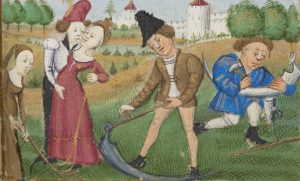67 Women in the Latin West Middle Ages

The lives of women in the Middle Ages were determined by the Church and the aristocracy. The medieval Church provided people with the ‘big picture’ of the meaning of life and one’s place in it; the aristocracy ensured that everyone stayed in their respective places through the feudal system of government which divided society into three classes: clergy, nobility, and serfs.
Women’s place in the clergy was restricted to the nunnery. Noble women’s positions were dictated by how much land they brought to marriage because land equaled power; therefore the quality of life and opportunities for autonomy could vary significantly among the upper class. Women of the lowest class actually had more freedom of expression than the other two because life was uniformly difficult for the serfs—male or female—and women worked alongside men in the fields and in the medieval guilds as equals or near-equals.
Throughout the Middle Ages, lower-class women were bakers, brewers, milkmaids, barmaids, artisans, weavers and, primarily, tenant farmers who worked alongside their husbands and children in the fields. The feudal system dictated that the land belonged to the lord, who rented it to his tenants—the serfs—who were bound to that land. The lord controlled every aspect of the serf’s life and this extended to a man’s wife and daughters.
The lord decided who a girl would marry, not the girl’s father, because the daughter of a serf was essentially property of the lord just as her father and mother were. Once the girl was married, her husband controlled her interests and was responsible for her behavior and, for this reason, women are not mentioned as often as men in legal matters in the Early Middle Ages. The woman’s husband would be sued if a woman transgressed, not the woman herself. The woman’s job was to take care of the home, help her husband at his work, and produce children.
An emphasis on trade during the High Middle Ages provided greater opportunity for women. During this period, in Spain and France initially, the middle class began to emerge as merchants amassed enough wealth to be able to influence political matters. Women of the new bourgeoisie could work with their husbands and fathers in a given trade and frequently succeeded the male as head of the business upon his death. The lowest class of the serfs and the upper-class noble women continued to live more or less as women had before them and both were tied to the land in one way or another.
It is unclear whether more women entered nunneries during this period but it is known that nuns were illuminating manuscripts as early as the 10th century CE, there were female scribes by at least 1274 CE, and more women seem to have been involved in book production in the 14th century CE than before. Female religious orders seem to have remained stable, but a new order, the Beguines, started in the 13th century CE in France, quickly gained a significant number of adherents.
Married women of the middle-class in the High Middle Ages routinely took care of their husband’s business accounts and took over after his death. This practice became more widespread following the Black Death pandemic of 1347–1352 CE when women regularly operated their late husband’s or son’s business, gained title to their lands, and had greater autonomy than before. Noble women, who had been expected to manage their husband’s estate and vassals when he was called away on business or to war, now became solely responsible for operations and transactions following the death of their husband and sons.[1]
- "Women in the Middle Ages" by Joshua J. Mark is licensed CC BY-NC-SA 4.0 ↵

